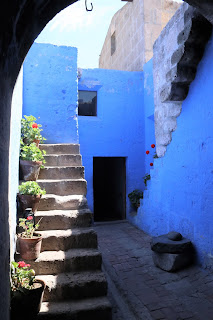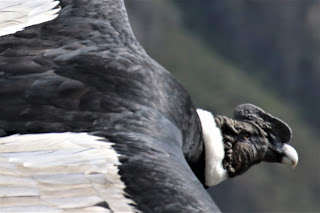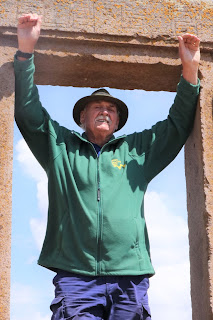Doorway, Bishop's Palace, Arequipa
Bishop's Palace
Our
stay in Arequipa lasted a full six days, not entirely on account of it being a
beautiful city and a delightful hotel, but also because we recalled that every
hotel, hostel, cabana and campsite was completely full when we turned up in
Mendoza on Easter Saturday last year. This time, having found somewhere decent,
we decided to stay put until after the Easter break.
The
beautiful central square, the Plaza de Armas, appeared to be very much the
focus of the city’s social activity and we whiled away many a happy hour
strolling around it or sitting and people watching. The huge cathedral, which dominates one side
of the plaza, seemed to be almost permanently shut and on the one occasion when
we found it to be open Alan was turned away on the grounds that his legs were
not fit for Peruvian society to see.
Apparently, shorts are not allowed.
Cathedral, Plaza de Armas
Façade of San Francisco Church
Granite portals on one side of the plaza
With
plenty of time on our hands we made a couple of excursions into the countryside
around Arequipa. We had a look at some nearby villages and saw some good
examples of pre-Inca terracing still in use today and still as functional as it
was then. One village featured a
reconstructed 17th century water mill with the strangest mill wheel
that either of us has ever seen.
Pre Inca terracing, village near Arequipa
Strange 17th Century water wheel
Leaving
the villages behind we made the long uphill drive to the Laguna Salinas. It was only 65 km, but it took a couple of
hours because the road was dirt with many hairpin bends and steep drops at the
side of the road which made Sue rather nervous. When we finally reached the
4,000 metre high plateau, the view that awaited us was worth it. The lake was large and shallow with duck and
flocks of flamingo in the distance and mountains all around.
Laguna Salinas
Volcan Misti, always visible from Arequipa
Grazing
along the shores of the lake were herds of llama and alpaca, being looked after
by an old hag who kept coming up and asking for sweets and money. Sue gave her some bread and meat which was
received without any good grace and then when Alan was trying to take some
photographs, she kept trotting along behind him murmuring “Maestro, maestro,
por favour”. By the shape of her, which
was more or less cylindrical, we didn’t think she was particularly short of
nourishment.
Juvenile llama, Laguna Salinas
Herd of llamas grazing by Laguna Salinas
Close up of adult llamas
We
also had a monumentally horrible drive to the coast to visit a lagoon based bird
reserve. It was horrible because the surrounding countryside, if you can call
it that, was sometimes desert and sometimes semi-desert, not even decently
desert because there were no nice clean sand dunes, just rocky, shoddy, shabby
bits of sandy, messed about hills with nothing growing on them whatsoever. When we eventually reached the bird reserve
the light was already fading but the lagoons were full of bird life and we enjoyed
our brief visit.
Turkey vulture at the bird reserve
Turkey vulture too close for comfort
One of
the highlights of our stay in Arequipa was our visit to the Convent of Santa
Catalina. This enormous complex is like
a city within a city and housed almost two hundred secluded nuns and their
servants from the late 16th century until 1970. Sue remembered the convent from her visit 13
years ago, and in particular being moved by the way in which young girls were
entered into the convent in its early days.
Wealthy families would place their second born daughter at the age of 11
or 12 into the convent as a sort of insurance to square themselves with the
Almighty, and there they stayed for the rest of their lives.
The
buildings within the convent are absolutely lovely. There are wonky white sillar stone walls
(sillar is the local volcanic stone and a very beautiful stone it is too),
nun’s cells with beds in the alcoves (to protect them from the frequent
earthquakes), kitchens with earth ovens
and great cauldrons and holes in the ceiling where fumes escaped, various
cloisters for the novices and the time served nuns, and lovely barrel vaulted
ceilings in places. There are lovely
fountains, a maze of narrow streets, and everywhere you look there are
geraniums and hibiscus and oleander growing in profusion.
Cloister, Convent of Santa Catalina
A little corner of the convent
Stairway to heaven, Convent of Santa Catalina
Nun's kitchen
Cloister
Sue on stairway
Street inside the Convent
Street in the Convent
Convent laundry
Flowering shrub in courtyard
Door Panel detail
Fountain in one of the courtyards
On
Easter Sunday we had a very lazy day. We
strolled back down to the plaza which was an excellent place for people
watching. There were little children chasing bubbles and each other and
beautiful young things posing in front of the fountain and photographing
themselves and each other from every possible angle. Coupled with that, there were sellers of
squeaky toys, sellers of ice cream, meat pies, cakes, jellies and bubble making
machines. There was a slightly
half-hearted parade that came past the Cathedral with an oompah band and people
dancing, so we went and had a look at that.
Chasing bubbles, Plaza de Armas
Band playing in the plaza
Close up of happy dancers
Dancers in the square
Elderly dancer
Distributing sweets
Sweet dispenser
Dancers
On
Easter Monday we left Arequipa and headed for the Colca Canyon, one of several
that claim to be the biggest or deepest in the world, also where sightings of
Condors are guaranteed. Our journey there took us above the snow line where our
altimeter registered 4,900 metres and dear old Lucy was puffing and panting
like a marathon runner on the last mile, but she made it.
What
we found when we arrived was a mighty canyon, about 1.2 km deep in places, with
varying degrees of steepness on the sides and dramatic craggy rocks with ice
capped mountains beyond. The first mirador that we stopped at gave us vertigo. Standing on the edge of the canyon, we looked
down past the pre Inca terraces upon which the locals grow their food and then
the whole thing fell away and we were looking over a kilometre down to a
crashing river which was so far away that whilst we could see the water and the
shimmer of sunlight upon it we couldn’t hear the river.
We
stopped for the night at a small hotel and then were up at six the following
morning to go to the ‘Cruz del Condor’ in the Canyon. At about eight am several condors appeared,
flying with complete mastery on the thermals within feet of us, flying along
the valley, then with Immelmann turns on a wing tip and flying back in the
other direction to show us their other sides.
This was marvellous, we enjoyed it hugely and so did quite a lot of
other people who were also there watching.
Approach to the Colca Canyon
Colca Canyon
Colca Canyon
Colca Canyon
Male Andean Condor
Up close and personal
Male Andean Condor showing splayed wing primaries
Adult male Andean Condor
Female Andean Condor
After
that we set off in the direction of Cusco which is when things
started to go wrong. The route had been
planned on what the map claimed was a tarmac road. The map however was guilty of a bare faced
lie. It was a dirt road which went up
over the mountains up to about 4,500 metres, it was heavily rutted, there were
potholes such that you drove down one side of them and up the other. It was
narrow, there were hairpin bends, oh and there were big trucks and buses.
After
about four hours we got onto what Sue described as an even more minor road
which the map did not even claim to be sealed.
It certainly wasn’t sealed, and it led to a river. The river was fairly wide and quite shallow,
probably not more than about two and a half feet deep but it was running fairly
quickly. There was a bridge, but the
bridge was broken in the middle.
Somebody had put a great big pile of earth on our side of it, clearly
demonstrating that one should not attempt to cross it. There followed a discussion about whether we
should attempt to drive across the river, but we erred on the side of caution and
abandoned the idea. This of course meant
that we had the tedium of driving another four hours along the same mountain
road, this time in reverse. Not one of our best days!
After
spending an unintended second night back in the Colca Canyon we then
successfully completed our journey to Cusco in two days, this time on main
roads. Cusco was once the capital city
of the Inca Empire and is the place from which you reach Machu Picchu. More of this in our next blog post.















































































